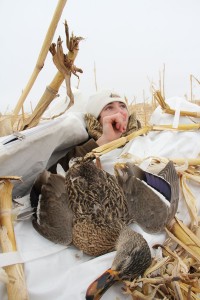August 13, 2012
By David Hart
 In 1989, Delta Waterfowl adopted a program that encouraged hunters to shoot fewer hens, called "Voluntary Restraint." It came on the heels of a string of poor hatches and a sharp drop in overall duck numbers. The goal was to boost survival of hens and ultimately rebuild duck populations on the backs of those additional females that survived hunting season. Since then, a legion of hunters turned voluntary restraint into a religion. Not only do they refuse to shoot a hen, they chastise others who pull the trigger on anything but a drake.
In 1989, Delta Waterfowl adopted a program that encouraged hunters to shoot fewer hens, called "Voluntary Restraint." It came on the heels of a string of poor hatches and a sharp drop in overall duck numbers. The goal was to boost survival of hens and ultimately rebuild duck populations on the backs of those additional females that survived hunting season. Since then, a legion of hunters turned voluntary restraint into a religion. Not only do they refuse to shoot a hen, they chastise others who pull the trigger on anything but a drake.
Whether a result of peer pressure or a conservation ethic, there is no question hunters are selective about what they shoot. A 1991 survey of Illinois waterfowlers showed 74 percent avoid shooting hen mallards. According to wing survey data, hunters kill between two to three drake mallards for every hen they harvest. That ratio has been relatively stable for at least 20 years.
But what about ducks whose sexes look alike? Male and female black ducks are nearly impossible to distinguish, which explains why an equal number of each gender are killed each year. Based on the "dead hens don't lay eggs" mantra used by so many conservation-minded hunters, it would seem logical that black duck populations would be struggling. But they aren't. Although black duck populations are well below long-term averages, due largely to the continued loss of winter habitat, their numbers have been relatively stable for the past 15 years.
There are no studies that have specifically examined the effects of VR on duck populations, but many biologists agree it has little measurable effect.
Advertisement
"If you look at species with sex-specific harvest restrictions — and there's only one: mallards — you will see that there are no discernible differences in long-term population trends compared to species that don't have sex-specific harvest restrictions," says Louisiana Department of Fisheries and Wildlife waterfowl study leader Larry Reynolds.
That is because hunting plays a minor role in duck mortality. Graphs of most duck populations generally follow the same zigzag pattern as the amount of water on the primary nesting grounds. So does the number of ducks killed by hunters. Good nesting conditions in the spring, not a decline in harvest the previous fall, equal more birds.
"Studies have shown that hunting-specific mortality of hen mallards is about 7 or 8 percent. In other words, 93 percent of all hen mallards are unaffected by hunting regulations. The annual mortality rate from all causes is about 40-45 percent for hen mallards, and thus hunting accounts for probably less than 20 percent of annual mortality," says Reynolds.
Advertisement
But even if hunters take just a small percentage of hens, wouldn't shooting fewer females boost duck numbers in the long run? Reynolds points to the various periods when harvest regulations were restrictive, moderate and liberal, including a long period when the limit on mallards in the Pacific Flyway was seven. All of those seven could be hens. That changed in 1984 when duck populations slipped from near-record highs around 1980 to near-record lows five years later, thanks to a series of dry years in the nesting grounds. What was once a liberal bag limit went to a restrictive one; hunters were allowed just one hen mallard. Instead of voluntary restraint, hunters were practicing mandatory restraint. Forced or voluntary, the results were the same.
"Based on the idea that shooting fewer hens means more ducks the following year, we should have been covered up in mallards in the years after the bag limit was reduced. That wasn't the case," says Reynolds. "Populations generally follow nesting conditions. In dry years, duck numbers go down and in wet years, they go up."
Reynolds says hunting plays a smaller role than most think in the overall mortality of hens and that many hunters are looking only at individual birds instead of the overall population. Survival doesn't stimulate duck numbers. Nest success and recruitment, driven largely by the abundance of water, matters most.
Dr. Jim Sedinger, a professor of wildlife ecology at the University of Nevada-Reno, examined duck harvest and its impact on overall populations and found no correlation between harvest rates and duck survival rates. He did, however, find that the higher the overall population of ducks, the lower the survival rate. Harvest, in other words, is compensatory, not additive, which means that those ducks (or the subset of ducks) killed by hunters would have died anyway. Hunting mortality is not added to the other mortality factors.
 He cited a study that examined pintail band recovery data for 30 years of liberal regulations and 30 years of restrictive regulations. Similar to Reynolds' observations, Sedinger said pintail numbers did not increase following a significant change in bag limits that reduced the hen harvest, even though overall harvest rates fell by half. Prior to the 1983 season, hunters were allowed seven pintails and all of them could be hens. The U.S. Fish and Wildlife Service dropped the daily bag limit to two pintails, of which only one could be a hen.
He cited a study that examined pintail band recovery data for 30 years of liberal regulations and 30 years of restrictive regulations. Similar to Reynolds' observations, Sedinger said pintail numbers did not increase following a significant change in bag limits that reduced the hen harvest, even though overall harvest rates fell by half. Prior to the 1983 season, hunters were allowed seven pintails and all of them could be hens. The U.S. Fish and Wildlife Service dropped the daily bag limit to two pintails, of which only one could be a hen.
"We should have seen an increase in survival rates, but we didn't," says Sedinger. "The same number of ducks were dying (from all causes) after the bag limits changed. There was no impact on survival rates despite a decline in overall harvest."
Sedinger says many hunters and even some wildlife managers miss the purpose of hunting regulations and bag limits.
"We are trying to regulate survival, not recruitment. Those are two completely different things," he adds. "We have to look at the population as a whole, not just individual birds. Duck populations are highly prolific under good wetland conditions and have the capacity for rapid increase even if harvest rates were too high for a short period."
In other words, shoot a hen if you feel like it. But if you don't, lay off the guy who chooses to add some brown to his duck strap.

